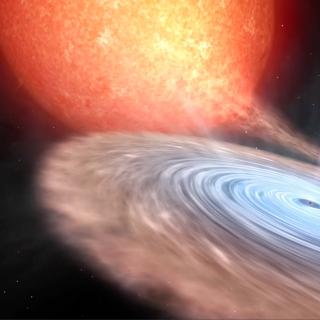Bibcode
Buisson, D. J. K.; Altamirano, D.; Armas Padilla, M.; Arzoumanian, Z.; Bult, P.; Castro Segura, N.; Charles, P. A.; Degenaar, N.; Díaz Trigo, M.; van den Eijnden, J.; Fogantini, F.; Gandhi, P.; Gendreau, K.; Hare, J.; Homan, J.; Knigge, C.; Malacaria, C.; Mendez, M.; Muñoz Darias, T.; Ng, M.; Özbey Arabacı, M.; Remillard, R.; Strohmayer, T. E.; Tombesi, F.; Tomsick, J. A.; Vincentelli, F.; Walton, D. J.
Referencia bibliográfica
Monthly Notices of the Royal Astronomical Society
Fecha de publicación:
6
2021
Número de citas
19
Número de citas referidas
16
Descripción
We present the discovery of eclipses in the X-ray light curves of the X-ray binary Swift J1858.6-0814. From these, we find an orbital period of $P=76841.3_{-1.4}^{+1.3}$ s (≍21.3 h) and an eclipse duration of $t_{\rm ec}=4098_{-18}^{+17}$ s (≍1.14 h). We also find several absorption dips during the pre-eclipse phase. From the eclipse duration to orbital period ratio, the inclination of the binary orbit is constrained to i > 70°. The most likely range for the companion mass suggests that the inclination is likely to be closer to this value than 90. The eclipses are also consistent with earlier data, in which strong variability ('flares') and the long orbital period prevent clear detection of the period or eclipses. We also find that the bright flares occurred preferentially in the post-eclipse phase of the orbit, likely due to increased thickness at the disc-accretion stream interface preventing flares being visible during the pre-eclipse phase. This supports the notion that variable obscuration is responsible for the unusually strong variability in Swift J1858.6-0814.
Proyectos relacionados

Agujeros negros, estrellas de neutrones, enanas blancas y su entorno local
Los agujeros negros y estrellas de neutrones en binarias de rayos-X son laboratorios únicos para explorar la física de estos objetos compactos. No solo permiten confirmar la existencia de agujeros negros de origen estelar a través de mediciones dinámicas de sus masas, sino que también permiten investigar el comportamiento de la materia y la
Montserrat
Armas Padilla